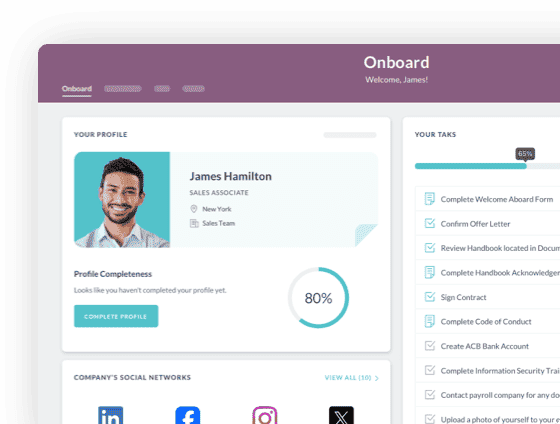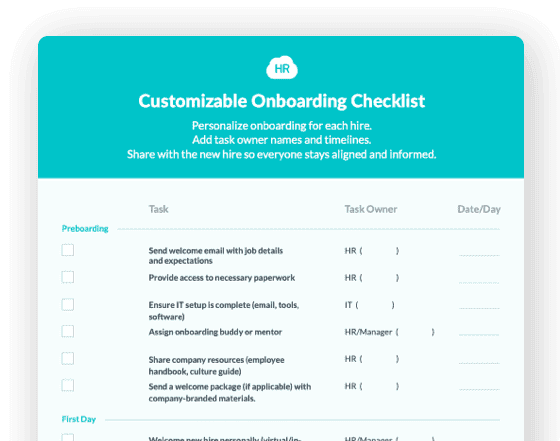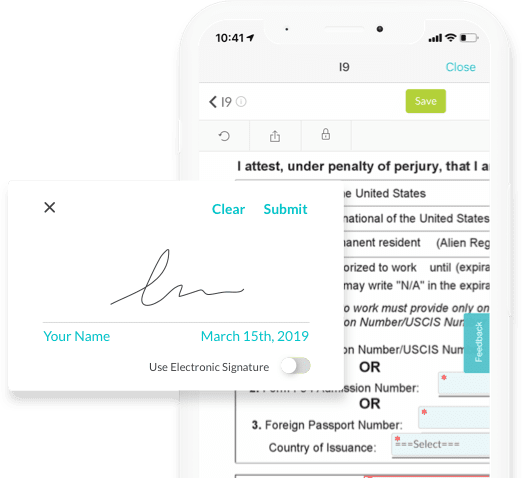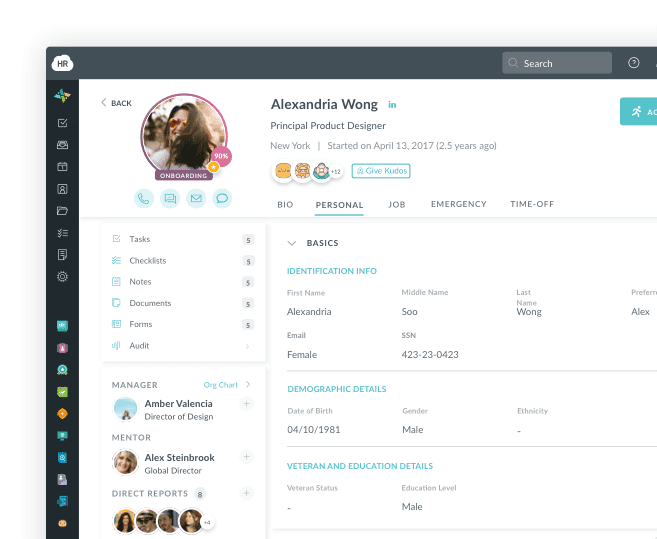Revolutionizing Onboarding: Modern Approaches to Welcoming New Hires
.png)


 Cut onboarding time
by 60%—here's the
Ultimate Checklist
that helped do it.
Cut onboarding time
by 60%—here's the
Ultimate Checklist
that helped do it.

Adding new talent to your team is exciting since it creates opportunities for you to grow as an organization. Fresh minds bring fresh ideas, which can provoke unique thoughts and stimulate action on your team.
It's crucial to ensure that your onboarding process helps them assimilate with the rest of the team to set your new hires up for success.
In this article, we'll discuss what business owners need to know about welcoming new hires in a way that sets them up for success. We'll talk about some modern approaches to onboarding that prioritize professional development, employee satisfaction, and company culture.
Defining Modern Approaches to Onboarding
Did you know that exceptional onboarding increases employee retention by 82% and productivity by 70%? In the past few years, the way that many businesses onboard new hires has shifted, and strategies like remote onboarding and mentorship programs have become the norm.
The purpose of this shift is to enhance the employee experience and improve job satisfaction and retention rates. Keeping your team happy reduces employee turnover, which helps build a tenured team and reduces hiring costs.
Some specific techniques used in these approaches include:
-
Virtual onboarding checklists
-
Integrating diverse groups of employees
-
Cohort onboarding
-
Pre-onboarding team mixers
-
Gifting branded merch
-
Personal development exercises
-
Creating memorable first days
These techniques are meant to set new hires up for success while setting the tone for your company culture.
Revolutionizing Company Culture
One modern approach to onboarding is setting the stage for a positive employee experience by creating a culture your employees want to be part of. Let's explore a few culture-focused onboarding techniques.

Communicating Company Values and Mission
It's essential to effectively communicate company values and mission to new hires right off the bat. You should share the company's mission, vision, and values from day one of the onboarding process.
Some ways to ensure that new hires remember and adopt your core values include:
-
Encourage leaders to embody your values in all that they do
-
Reward behavior that aligns with your company culture
-
Publicly call out individuals who represent your core values
-
Organize events and initiatives that showcase the company's mission and values
-
Use internal communications platforms to educate employees
The more you reinforce these values in everyday situations, the more likely your team will remember to put them into action.
Creating a Supportive Environment for New Hires
Whether you're hiring contractors or employees, creating a supportive environment for your team is crucial. Some key ways to foster a supportive environment include prioritizing flexibility, inclusivity, and diversity in the workplace.
Hybrid and remote work environments are becoming more popular since they provide employees with greater flexibility. For many, this creates a positive experience that yields a greater work-life balance for your employees and often stimulates productivity.
Inclusion and equity are imperative to maintaining a productive team. You can promote inclusivity and diversity with exercises like unconscious bias training and recognizing inclusive behaviors among your team members.
By creating a culture of recognition, you'll make employees feel valued and motivated. This starkly differs from the culture of only calling people out for mistakes. Recognizing positive behaviors is a surefire way to boost employee morale.
Onboarding vs. New Employee Orientation
Part of maintaining the company culture is to ensure that onboarding is an ongoing experience for your new hires. This is extremely important to call out since it's easy to assume that onboarding and new employee orientation are the same.
If you're unfamiliar with the differences, new employee orientation introduces new hires to their jobs, colleagues, and the organization. In contrast, onboarding goes beyond orientation and is meant to continuously assimilate new hires with the team. Onboarding focuses on teaching new employees about the company culture, their role, and how they can contribute to its success.
Onboarding is just as essential for new businesses as for established companies, if not more so. Why? It costs more to replace employees than to retain them. So, when you start a business, it's imperative to invest in the right tools (HR resources) to start on the right foot.
Specially for new businesses, employee onboarding is about more than just paperwork and policies. Once you have a legit business on its feet, with a solid structure and stable foundation, you need to have a comprehensive process that aims to make new employees feel valued, informed, and capable of contributing to your business's success. A well-executed onboarding program can lead to a positive, productive, and engaged workforce, which is essential for the growth and success of your new business.
Revolutionizing Professional Development
Hiring talented people is important, and harnessing their talent is equally important. A great way to do this is by incorporating professional development as part of an ongoing initiative that starts with onboarding.
Offering Training and Development Resources
Promoting professional development for your new hires is a great way to show them you're invested in their success. Investing in your team helps build rapport with new hires and equips them to serve your team better.
One way to promote professional development is by presenting learning and growth opportunities. Some of these opportunities include virtual conferences, cross-staff training, soft-skill development, implementing a learning management system and continuing education. Tuition reimbursement is another great option because it encourages employees to take professional development into their own hands.
These resources will help upskill your team to stay on the cutting edge of industry trends. Plus, it'll help your company stay ahead of the competition.
Ajay Chandrasekaran, Content Marketing Manager at zoho.com, shares his valuable thoughts on managing seasonal hiring: “Offering training resources is essential in seasonal hiring, too, and the easiest way to help new employees get acclimatized to their new workspaces is to have an onboarding checklist for each major role. It need not be a rigid set of steps or a legal document. Instead, one can build and apply a fun slide deck or even a simple outline in the form of flashcards that the recruiter can customize for the people in their care.”
His insights include building a video course or a small hands-on training program for recruits- These types of efforts go a long way in getting them up to speed before the holiday season. On top of this, managers should also have a do's and don'ts document and conduct simple drills and quizzes to ensure that the people coming in are ready to handle all standard work situations.
Ajay concludes with the following thoughts on investing time and resources when it comes to seasonal hiring: "Your seasonal temps are not just extra hands to power through a busy season, but also brand ambassadors and potential long term hires. Invest in their training and growth just like you would do for yourself, and in time, your hires will do the same for you and your business. After all, what goes around, comes around."
Forming Mentorships Between Senior Staff and New Hires
Mentorships are becoming a staple in modern onboarding practices. Developing mentorship relationships between senior staff and new hires is a great way to provide hands-on training.
Mentors can welcome newcomers, offer guidance, and facilitate a sense of belonging in the workplace. Mentorships also create opportunities to cultivate talent in a way that's impossible with generic training materials.
Since mentorship provides new hires with personalized interaction with more seasoned members of the team, it's easier for them to learn the ins and outs of the role (and organization).
Creating positive relationships among your team can contribute to employee engagement, motivation, and job satisfaction. It can encourage your team to work together and help people get more excited about coming to work.
Establishing Clear Objectives for Success in the Role
Without goals, it's difficult to create a roadmap toward the success that your business needs. With that in mind, having specific goals and objectives for your new hires is essential. It helps employees understand expectations and motivates them to strive for success.
In addition to the objectives you create for new hires, you should encourage them to develop their own goals. Challenge them to dig deep to determine what they'd like to contribute to your organization and how they plan to grow personally.
Take Advantage of E-Forms, Time-Off Tracking, and Other Powerful Features to Help Drive Your Bussines
Learn More about HRMS
Revolutionizing Job Satisfaction & Employee Retention
We've discussed the benefits of job satisfaction and employee retention. However, you may be left wondering how to put this into action. Here are a few ways to revolutionize employee satisfaction and retention with better management.
Understanding Employees' Needs, Wants, and Expectations
If your goal is to improve employee satisfaction and retention, it's vital to understand employee needs, wants, and expectations. You need to understand what motivates your employees to clock in every day if you want to create a positive employee experience.
An easy way to gain this insight is by taking the time to chat with your team. Check in with people regularly to see how things are going and their experience. Starting these conversations early with new hires will help build trust and open communication.
Another way to gather this information is by sending out surveys and giving your team the option to express their wants and needs anonymously. People might be more comfortable opening up if their name isn't attached.
Once you have a clearer picture of your employees' needs, it's crucial to ensure that your leadership team can adjust and offer the support required to meet these needs and improve employee retention.
Developing an Employee Value Proposition (EVP)
If you're unfamiliar, an employee value proposition (EVP) is the value you provide for your employees in exchange for the hard work and dedication they provide for your company. This can be thought of as your benefits package.
By providing a comprehensive EVP to current and prospective employees, your organization will be a more appealing place to work.
As you create your EVP, it must align with the company's mission, culture, and values. For example, giving employees plenty of PTO is important if work-life balance is vital to your organization.
Fostering Great Management
Fostering great management by establishing a vision, purpose, and transparency within the organization is another great way to keep your employees happy and reduce turnover rates.
Doing so requires collaboration and participation from all levels of management, especially middle managers. Middle managers are often key players in setting goals, supporting employees, coaching for high performance, and providing employee feedback.
It's important to prioritize transparency to manage your team effectively. Being honest and transparent with your team will build trust and enhance employee loyalty.
Key Takeaways
The evolution toward modern onboarding approaches has become commonplace in the business world across many industries. That alone should motivate your organization to stay on trend in creating more powerful onboarding experiences for new hires.
You can improve job satisfaction and employee retention by prioritizing a positive company culture and setting your new hires up for success. Navigating onboarding with this attitude will create a more positive experience for your employees and you as an employer.
Which modern onboarding techniques will you use with new hires?
Is Your Company's Culture
Working Against You?
culture with our short quiz.
Author Bio
Guillaume is a digital marketer focused on handling the outreach strategy at uSERP and content management at Wordable. Outside of work, he enjoys his expat life in sunny Mexico, reading books, wandering around and catching the latest shows on TV.
Keep Reading
AI for Frontline HR: Moving Beyond Sentiment Analysis to Build Tomorrow's Workforce Management Engine
TL;DR: While most organizations limit artificial intelligence in human resources to basic
How to Onboard Nurses and Clinical Staff Without Burning Out Your HR Team
Healthcare HR teams spend up to 57% of their time on administrative tasks, and onboarding
The Definitive Guide to Onboarding Field & Clinical Staff in Healthcare (2026)
Key findings covered in this guide:
The turnover crisis: 58% of nurses report burnout
Like What You Hear?
We'd love to chat with you more about how HR Cloud® can support your business's HR needs. Book Your Free Demo

Build a Culture of Recognition. Boost Engagement. Guaranteed.
Workmates empowers employees to stay informed, connected, and appreciated—whether they’re on the front line, in the office, or remote. Recognition drives 12x higher engagement.Trusted by industry leaders in every sector




Cut Onboarding Costs by 60%.
Take the confusion and follow-ups out of onboarding with automated workflows, digital forms, and structured portals—so new hires ramp faster 3X quicker.Trusted by industry leaders in every sector





